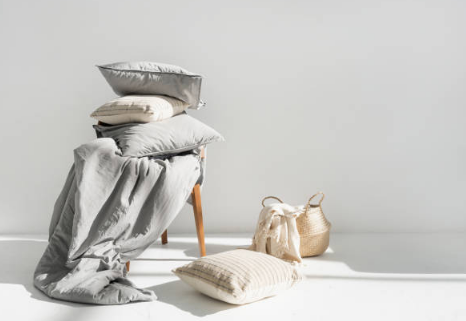Washing pillows, quilts, and other down-filled items is sometimes the last item on the laundry list. In fact, many people don’t know how to wash a duvet or realize they can. While these items tend to be quite bulky, you can usually wash duvets, pillows, and jackets in the washing machine at home. Most manufacturers recommend washing items infrequently, so you don’t need to do this washing process too often.
When it’s time to clean down items, follow the steps below to wash and dry duvets, down pillows, sleeping bags, and jackets for best results.

Can I Wash Comforters and Pillows at Home?
Quilts for full-size beds, queen-size beds, and king-size beds can be too large for standard-sized household washing machines. For best results, use a high-capacity front-loading washing machine, such as one at your local laundromat. On the other hand, a feather pillow may be small enough to be washed in a washing machine at home, which is a more convenient option, especially if you have a front-loading washing machine. However, if you have a top loader, you may need to use a front loader at a laundromat. Blenders can be rough for delicate down products.
How to Wash Duvets and Pillows
Be sure to read and follow the specific instructions on the label on how to wash your duvet. Before washing, check for frayed stitches or holes and repair them with fine stitches to avoid losing any down filling during washing.
Before washing your duvet or pillow, check for stubborn stains such as blood or urine. These stains are best treated with an enzymatic cleaner ($12, Target). Color-safe bleach ($8, Target) can be used to remove stains caused by water or food. When dealing with stains topically, pull the cover of the quilt or pillow away from the down to prevent damage to the down with cleaning products. Once the stain has been removed, your down products are ready to be washed.
What Is the Best Wash Cycle for Duvets and Other Down-Filled Items
Using a gentle or gentle mode and adding a minimal amount of mild laundry detergent to your laundry is the best way to wash your duvets, pillows, or other items. Choose warm water, as both hot and cold water can harden the down. An additional rinse cycle helps to ensure that all soap is removed from the down. There are also special laundry detergents for washing sleeping bags, duvets, and other down-filled items. You can usually find these cleaners at online and outdoor retailers.
To prevent the down from wrinkling, place a pair of clean white canvas shoes (with the laces removed) or a sock stuffed with two tennis balls (secured with a knot) in the machine with a quilt or pillow. This addition also gently stirs up the dirt on the item to be cleaned.
How to Dry Items
When washing is complete, place the duvet, pillow, or other down item in a dryer large enough to leave enough space. Add a pair of tennis balls or wool dryer balls tied to your socks to help fluff up the down and distribute it evenly.

What is the best dryer setting for down items
Run the dryer in fluffy air or at the lowest possible temperature. Stop the dryer regularly and break up any lumps on the quilt or pillow. Make sure the down doesn’t get too hot, as extreme heat can scorch the down. The drying process is expected to take three to four hours.
To avoid mold, remove down products from the dryer only when they are completely dry. If the item is still slightly damp, place it on a clothesline on a breezy warm day to dry the down as much as possible. Once the quilt or pillow has been placed indoors, leave it for a few weeks to ensure that all the moisture has evaporated. If you’re storing a comforter, wrap it in a cotton sheet first.
How Often to Wash Down-Filled Items
You can always use a sheet under a duvet-covered quilt to protect your down. The sheet provides another layer of protection against body oil and dirt. Wash the duvet cover once a week if you don’t use linen or once or twice a year if you use linen.
To reduce the number of times you wash your duvet, add a duvet cover on top to prevent oil from your skin from seeping into the quilt and attracting dirt.
Some duvets and pillows come with clear instructions requiring dry cleaning instead of washing.
Pillow protectors and pillowcases will provide extra protection against stains and dust mites. Most pillowcases come with a zipper for extra protection, allowing you to wrap and remove the pillow for washing. Some cases and covers are made of cotton or cotton-polyester blend materials. Just as bed sheets provide extra protection for duvet covers, these duvet covers also protect down pillows from stains and dirt. Wash the pillow protector every 3 months.
A few times a year, bring a duvet or feather pillow outdoors on warm, breezy days to refresh them. Place the item on a flat surface and let it dry in the sun for two to three hours before sending it home.
No matter what type of down product you’re cleaning, the whole process starts with reading the manufacturer’s care label. This knowledge, along with some tips, will help you prepare for all the cleaning tasks of down products, including washing down jackets, cleaning duvets, and caring for down pillows.